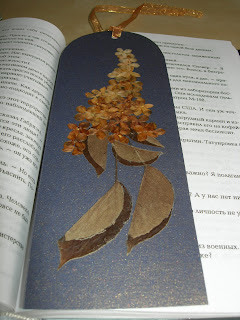Hello, my name is Liudmila. I was born in Lithuania, have family roots in Russia, but now I live in Norway:) I can't tell anything astonishing about myself... I'm not registered in the Guinness Book of Records, haven't invented the bicycle and wasn't elected as a president :D I'm an ordirary person with simple hobbies - love travelling, reading books, meeting my friends, I just love life as it is, with all advantages and disadvantages. I just have an interesting hobby - I collect bookmarks :) I'm a passionate bookmark collector and hope to find more collectors, exchange bookmarks with them, show my collection to others and have a look at other collections :) You can contact me, if you're interested in bookmark exchange :) Hope to find friends from all over the world :)
Friday, March 4, 2011
Dried flower - Syringa
Syringa (Lilac) is a genus of about 20–25 species of flowering woody plants in the olive family (Oleaceae), native to woodland and scrub from southeastern Europe to eastern Asia. They are deciduous shrubs or small trees, ranging in size from 2–10 m tall, with stems up to 20–30 cm diameter. The leaves are opposite (occasionally in whorls of three) in arrangement, and their shape is simple and heart-shaped to broad lanceolate in most species, but pinnate in a few species (e.g. S. protolaciniata, S. pinnatifolia). The flowers are produced in spring, each flower being 5–10 mm in diameter with a four-lobed corolla, the corolla tube narrow, 5–20 mm long; they are bisexual, with fertile stamens and stigma in each flower. The usual flower colour is a shade of purple (often a light purple or lilac), but white, pale yellow and pink, and even a dark burgundy color are also found. The flowers grow in large panicles, and in several species have a strong fragrance. Flowering varies between mid spring to early summer, depending on the species. The fruit is a dry, brown capsule, splitting in two at maturity to release the two winged seeds.
Labels:
Dried flowers,
Lithuania,
Paper
Subscribe to:
Post Comments (Atom)


Šio knygos skirtuko autorius yra nuostabi Lietuvos dukra Bite Birute:
ReplyDeletehttp://www.facebook.com/profile.php?id=1376224693
Taip,as tik vakar tai suzinojau,ji mane pati susirado,labai malonu susipazinti,dabar palaikom su ja rysi :)Tikiuosi mano kolekcija dar pasipildys jos naujais darbais :)Beje,nezinojau,kad tai alyva atkeliavusi is Kauno,maniau ji is Nidos,nes man ji pirko Nidoje...tai tas skirtukas visad primena nuostabiaja Nida,nors jis kiles ir is Kauno :D isties tai ilgiuosi Nidos kopu,idomu ar yra skirtuku su Nidos smeliuku? esu toki atviruka pirkusi,bet skirtukais dar tada nesidomejau,tai neatkreipiau demesio,gal buna ir tokiu,o gal kas nori man toki sumeistrauti :D ?...pasvajosiu...
ReplyDeleteMiela Liudmila, gaila, kad išsklaidžiau gerąją, mistiškąją, nidietišką žiedų aurą...;) Bet yra kaip yra. Skirtuką su Nidos smėliu pažadu. Dekoravimas smėliu-artimiausiuose planuose, kiti elementai-taip pat lietuviški... Nidos smėlis-visad šalia (kas, kad tik indelyje;)), nes nerijos kopos man-pati nuostabiausia vieta, ten taip artima sielai, kad kitur nė netraukia...
ReplyDeletePasistengsiu kuo greičiau įgyvendinti Tavąją svajonę.
Oj,nieko tokio,man niekas neissisklaide,as jei ka isikalu i galva,tai man ilgam,vistiek jis man Nidietiskas :D O vat del skirtuko su smeliu,tai pradziuginai :),labai noriu tokio,lauksiu labai,nes man tos kopos irgi kazkas magisko ir traukiancio siela visad ten sugrizti,pasiilgstu....Aciu labai uz nora igyvendinti mano svajone :)
ReplyDeletetest
ReplyDelete